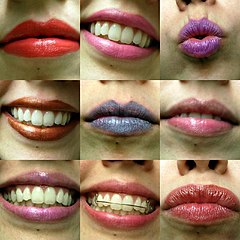A New Analysis of the Contents of Lipstick and Lip Gloss May Cause A Pause Before Puckering
Poison lips? Troubling levels of toxic metals found in cosmetics
By Sarah Yang

People may be adding a bit more than a touch of color to their lips, according to a new UC Berkeley study.
Researchers at UC Berkeley’s School of Public Health tested 32 different lipsticks and lip glosses commonly found in drugstores and department stores. They detected lead, cadmium, chromium, aluminum and five other metals, some of which were found at levels that could raise potential health concerns. Their findings were published online in the journal Environmental Health Perspectives.
Prior studies also have found metals in cosmetics, but the UC Berkeley researchers estimated risk by analyzing the concentration of the metals detected and consumers’ potential daily intake of the metals, and then comparing this intake with existing health guidelines.
"Just finding these metals isn’t the issue; it’s the levels that matter," said study principal investigator S. Katharine Hammond, professor of environmental health sciences. “Some of the toxic metals are occurring at levels that could possibly have an effect in the long term.”
Lipstick and lip gloss are of special concern because when they are not being blotted on tissue or left as kiss marks, they are ingested or absorbed, bit by bit, by the individual wearing them, the study authors said. The researchers developed definitions for average and high use of lip makeup based on usage data reported in a previous study. Average use was defined as daily ingestion of 24 milligrams of lip makeup per day. Those who slather on the lip color and reapply it repeatedly could fall into the high use category of 87 milligrams ingested per day.
Using acceptable daily intakes derived from this study, average use of some lipsticks and lip glosses would result in excessive exposure to chromium, a carcinogen linked to stomach tumors. High use of these makeup products could result in potential overexposure to aluminum, cadmium and manganese as well. Over time, exposure to high concentrations of manganese has been linked to toxicity in the nervous system.
Lead was detected in 24 products, but at a concentration that was generally lower than the acceptable daily intake level. However, the lead levels still raised concerns for young children, who sometimes play with makeup, since no level of lead exposure is considered safe for them, the researchers said.
The study authors say that for most adults, there is no reason to toss the lip gloss in the trash, but the amount of metals found do signal the need for more oversight by health regulators. At present, there are no US standards for metal content in cosmetics. The authors note that the European Union considers cadmium, chromium and lead to be unacceptable ingredients — at any level — in cosmetic products.
"I believe that the FDA (Food and Drug Administration) should pay attention to this," said study lead author Sa Liu, a UC Berkeley researcher in environmental health sciences. "Our study was small, using lip products that had been identified by young Asian women in Oakland, Calif. But, the lipsticks and lip glosses in our study are common brands available in stores everywhere. Based upon our findings, a larger, more thorough survey of lip products — and cosmetics in general — is warranted."
Ann Rojas-Cheatham, director of research and training at the Asian Communities for Reproductive Justice in Oakland, Calif., co-authored the study. The National Institutes of Health and the National Institute of Occupational Safety and Health Education Research Center helped support this research.
Editor's Note: FDA Product Information about Lipstick and Lead, Questions and Answers
FDA Analyses of Lead in Lipsticks – Expanded Survey (Table)
http://www.fda.gov/cosmetics/productandingredientsafety/productinformation/ucm137224.htm
More Articles
- National Institutes of Health: Common Misconceptions About Vitamins and Minerals
- Julia Sneden Redux: Age Rage; Sometimes You Just Have to Strike Back
- A Yale Medicine Doctor Explains How Naloxone, a Medication That Reverses an Opioid Overdose, Works
- Kaiser Health News Research Roundup: Pan-Coronavirus Vaccine; Long Covid; Supplemental Vitamin D; Cell Movement
- How They Did It: Tampa Bay Times Reporters Expose High Airborne Lead Levels at Florida Recycling Factory
- EPA Advances Science to Protect the Public from PFOA and PFOS in Drinking Water
- A Scout Report Selection: Science-Based Medicine
- Journalist's Resource: Religious Exemptions and Required Vaccines; Examining the Research
- Government of Canada Renews Investment in Largest Canadian Study on Aging
- Kaiser Health News: Paying Billions for Controversial Alzheimer’s Drug? How About Funding This Instead?







